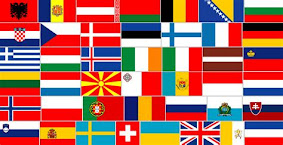War does not only occur on television in the remote North Caucasus. With Allah's will, the borders of military action will extend to cover the entire territory of Russia, and this year, great successes await us."~Terrorist Umarov quoted by Gazeta.ru (my translation)
Today's suicide bombings at two of my hometown's busiest subway stations were not simply acts of Islamic terrorism. Rather, they were an attack on the European civilization. One need not side with North American neocon foreign policy or gloss over the Russian regional specifics to see the global dimensions of this escalating East-versus-West civilizations' clash.
In addition to the death toll and gruesome details, news reports everywhere emphasized the fact that one of the subway stations in questions, Lubianka, is the current FSB headquarters, and, thus, is a spit in the face of Russian counterterrorism, after Nord-Ost and after Beslan. Instead, I recalled that the Moscow subway system is one of the most beautiful examples of public architecture in the world. Its central (yes, Soviet-era) stations, rich in marble and mosaics with a variety of neoclassical references, are an aesthetic symbol of European culture.
In other words, Russians had used a standard American solution in its respective geopolitical problem areas, involving money showers and pliable local leadership. And there were partial successes: while jihadists moved to neighboring Ingush and Dagestan regions, Chechnia itself calmed down somewhat.
As one may expect, this conflict has roots in the late imperial era. At that time, Russia did not have a unified cohesive policy to deal with its colonial subjects. Tsars crushed Polish rebellions, but led a remarkably liberal policy in Finland, leading to autonomy and, ultimately, independence. Likewise, in the Caucasus, Russia's relationship with dozens of different ethnicities, as well as neighboring powerhouses -- the Ottoman Empire and Persia, depended on a number of socio-political and cultural factors. Armenians, for instance, were the most dispersed and urban, while the Azeris were more compact and rural. Religion was and remains a crucial aspect of this relationship (I have already briefly summarized [Georgia Out of His Mind] how Orthodoxy played into Russo-Georgian politics over the past several centuries elsewhere). Christian Georgians and Armenians both possessed an ancient well-developed civilization, and the relationship with Russia was amicable, generally speaking. Muslim Chechens, Ingush, and Dagestanis, in contrast, led a more tribal, clan-based existence and resisted this Orthodox-led annexation.
In the Soviet period, Stalin's nationalities policy was shrewd, occasionally surprising, and often devastating. People of the North Caucasus certainly suffered under his rule, as he deported much of their population to Kazakhstan at the end of the Second World War. These policies worked in the short term and were often based on the principle of divide-and-conquer: in this particular case, the General Secretary combined two rival peoples into a singular Checheno-Ingushetia administrative unit. In the long term, however, Russians found themselves amidst two consecutive wars in the North Caucasus after the Soviet collapse.
Nineteenth-century Russian poet Lermontov had written, "Angry Chechen crawls ashore, sharpening his dagger." This expression had become idiomatic, and is still quite relevant in the post-Soviet space.
The American and European officials have been pledging solidarity with Russia in the so-called global war on terror as they get deeper entrenched in the Middle East and Afghanistan. At the same time, their media mouthpieces, particularly CNN in the U.S. case, have been smirking at "freedom fighters" and "rebels" in the Russian borderlands. This foreign policy schizophrenia (they call it "diplomacy") stems from naïve attempts to democratize the world, on the one hand, and opaque post-sensitivity training, post-colonial rhetoric, on the other. Apart from cultural Marxism, however, there is a bigger, real-politik issue at hand.While the Kremlin obviously does not want to lose access to the natural resources in the North Caucasus, the European and American establishments are motivated by twenty-first century Lebensraum ideology -- the Brzezinski doctrine directed against the Russian control of Eurasia.
In hindsight, it is questionable whether Russia should have gotten involved with the Muslims of the North Caucasus led by Imam Shamil a hundred and fifty years ago in the first place. However, when it comes to geo-historic context, Russian and American frontier drives westward in the 19th century were not as dissimilar as one might think. Therefore, a suggestion to give up control of the North Caucasus to Russians is not unlike arguing that Americans forfeit California, if not all of the southwest, to Mexico. Furthermore, leaving the region certainly does not solve the contemporary problem of the north Caucasian ethnicities living in European parts of the Russian Federation, ranging from service sector workers to wealthy individuals with vast connections in business and politics alike.
Russia's modern variation on its traditional imperial policy in the regions has only been partly successful: the state rebuilt infrastructure, but has not been able to protect the lives of its citizens. "Progressive" Euro-American welfare-state solutions like affirmative-action programs have not worked there either. As a result, suicide bombers target busy subway stations, while Chechen children refuse to learn the Russian language in Muscovite public schools. In London, politicians flirt with Sharia law, as that city gets further ghettoized. In France, second-generation Muslim rioters caused €200 million worth of damage in one year. In Sweden, the number of immigrant-linked rapes has quadrupled over the past twenty years or so. And, in Fort Hood, Texas...
Regional and policy differences aside, the failure to integrate one's own largely native-born Muslim citizens reveals the growing cultural and hyper-religious divide. This clash of civilizations produces people like Sayid the Buryat. The real name of this prominent terrorist is actually ...Aleksander Tikhomirov -- a half-Russian, half-Buryat (Buddhist (or Christian) Siberian-Mongolian ethnic group). He converted to Islam at 15 and left to study jihadist practices in Egypt and Yemen. Upon returning to Russia, he joined other militant fundamentalists in that country's southwestern borderlands.
Tikhomirov had been exterminated by the federal forces in Ingushetia at the beginning of this month. But, more daggers are being sharpened all over Europe.
































No comments:
Post a Comment
Your comment will appear after it has been checked for spam, trolling, and hate speech.